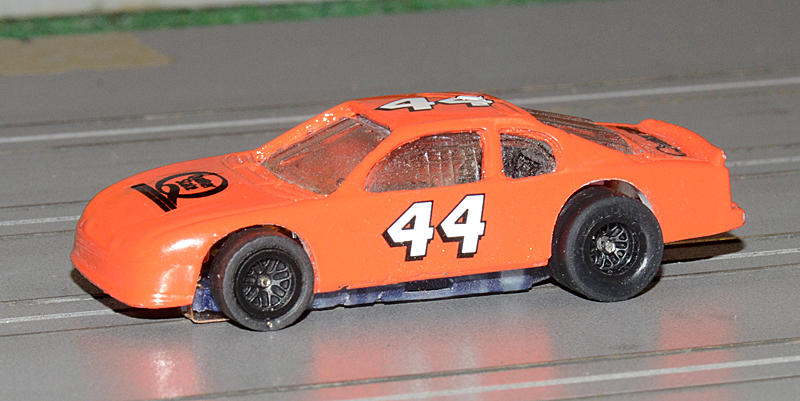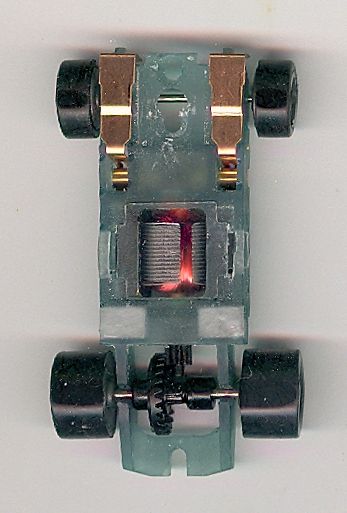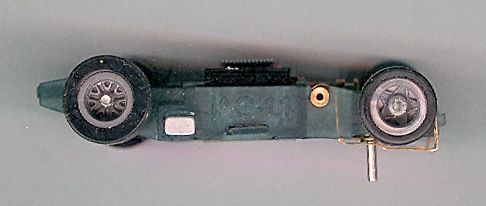Jim has introduced an inline chassis for T-Jet/screw on bodies. Check it out.
http://www.jaghobbies.com/
New chassis from JAG
16 posts
• Page 1 of 2 • 1, 2
Re: New chassis from JAG
Now THAT is a very cool thing to bring to the hobby's marketplace!
Thanks to Jim for all his efforts to do so.
Looking forward to playing around with one of these new chassis-- Ernie :>)
Thanks to Jim for all his efforts to do so.
Looking forward to playing around with one of these new chassis-- Ernie :>)
- BIG E
- HRW SlotCar Veteran!
- Posts: 939
- Joined: Fri Sep 07, 2012 11:30 am
- Location: NY/Metro area
Re: New chassis from JAG
I plan on ordering one of these cars, they should be good runners right out of the box.
-

RichD - HRW SlotCar Veteran!
- Posts: 1885
- Joined: Thu Sep 06, 2012 7:41 am
- Location: East Haven, CT
Re: New chassis from JAG
Nice to see as I like the variety available in the t-jet style bodies - I imagine, with the traction magnets pulled and the voltage turned down - it could make for some good racing! :D
-

TuscoTodd - HRW Bouncer
- Posts: 7145
- Joined: Sat Aug 17, 2013 11:25 am
- Location: Rural Ohio
Re: New chassis from JAG
in an e-mail to Jim, I mentioned that for over twenty years our club has raced some classes with the traction magnets removed and he replied to let him know what we would want since with the 3D printing he could make changes, so it seems that if you want a non-magnet style chassis he could print that. You would need to verify that with him to be sure. Possibilities are there and exciting. We'll see where this all goes.
- eastside johnny
- Posts: 25
- Joined: Wed Nov 05, 2014 8:06 am
Re: New chassis from JAG
A lot of people race regular inline cars with weights in place of the traction magnets, there are BSRT G-Jets, Wizzard Thunderstorms, Slottech Thunder Cats and Viper Scale Racing Viper Jets. The magnet pocket in the JAG chassis is very small. I tried using lead weights in an AFX Mega G+ chassis, which uses similar sized traction magnets and that did not work very well unless I dropped the voltage considerably. I do have a JAG car on the way and I will try running that without traction magnets. Look for a complete report by the end of the week!
-

RichD - HRW SlotCar Veteran!
- Posts: 1885
- Joined: Thu Sep 06, 2012 7:41 am
- Location: East Haven, CT
Re: New chassis from JAG
I am looking forward to your impressions of the JAG chassis without traction magnets, Rich D. That is how I would want to race them, but I think they could be a handful without low voltage and some additional weight.
Rick V.
Rick V.
- RV Racing
- HRW SlotCar Veteran!
- Posts: 196
- Joined: Thu Sep 06, 2012 4:01 pm
Re: New chassis from JAG
Here at North Coast H.O. we started racing Tyco X-2s back in the early/mid 90's with the traction magnets removed powered by an 8 volt tractor battery. They worked fine without any added weights, had enough speed to still have to drive them, and the electrical system LASTED A LONG TIME. Later we also did the same with Tomy Super G+ cars with favorable results as well. (these were all with hard bodies)
- eastside johnny
- Posts: 25
- Joined: Wed Nov 05, 2014 8:06 am
Re: New chassis from JAG
A few years back HOCOC had a Limited Sportsman class for Tyco 440X-2s with brass front wheels and brass weights in place of the traction magnets. We ran the cars with slip-on silicone tires at 12 volts and they were drivable, but there was little interest in that class and it was dropped after one season.
-

RichD - HRW SlotCar Veteran!
- Posts: 1885
- Joined: Thu Sep 06, 2012 7:41 am
- Location: East Haven, CT
Test Results
The JAG chassis weighs 13.1 grams and is 2.13 inches long and 0.69 inches wide. Measured across the rear wheels the car was 1.2 inches wide, the wheels could have been pressed on a little more to make the car narrower. The front wheels are 0.283 inches in diameter and the rear wheels are 0.275 inches in diameter. The front tires are Jel Claws and are 0.432 inches in diameter, the rear tires are a very soft silicone formulation and are 0.438 inches in diameter. One rear wheel had some runout. It appears that the front motor shaft bearing was installed backwards, so there was a fair amount of fore and aft play in the armature. Since the magnets wanted to hold the armature towards the back of the car in any case I did not correct that until I had done some initial testing. Like the Mega G chassis the motor magnets are not visible from the bottom of the car. I did some gauss readings with the traction magnets removed. I would have liked to have removed the motor magnets, which seem to be the compression molded polymer type, but I was afraid to break the chassis. The highest value that I could find was 1400 gauss. Measured on the bottom of the chassis the highest value that I could find was 480 gauss. Outside of the car the traction magnets measured as high as 1954 gauss on the side that would face the track rails. The magnets are 0.218X0.16X0.1 inches, smaller than Mega G traction magnets. When I put the car on a spare track section it hardly wanted to stick if it was turned upside down. With the stock front tires the front of the chassis rides high, so a certain amount of magnetic downforce would be lost.
Before I put the car on the track I broke the motor in at 3 volts for 30 minutes and 6 volts for 15 minutes. For a start I ran the bare chassis around my 50 foot long 4X16 MaxTrax.
With the track voltage set at 18.5 the car was a rocket down the straights, but was very difficult to drive. The best lap time that I could do was 4.523 seconds. The lap record for a T-Jet SS on my track is 5.4 seconds and a first generation Mega G car with Super Tires did 3.3 seconds. I replaced the stock front tires with Mega G front tires that are 0.390 inches in diameter and the car got a little easier to drive with a best lap time of 4.327 seconds. I did try another rear axle assembly, but that made no difference. Next I limited the pickup shoe travel and that was a big help, the best lap time went to 4.280 seconds. I then put a resin NASCAR style body on the car and got a best lap time of 4.678. Having a body on the car had little effect on the drivability. I also tried a Mega G+ chassis with Super Tires and a 3D printed Whelen Modified body, that was very easy to drive and did a consistent 4.1 seconds.
I did try dropping the track voltage to 16.5, that had little effect. At 14.0 volts the car was quite easy to drive and did a best lap of 4.826 seconds. Compared to running the car at 18.5 volts the car was not much slower and was much easier to drive.
I did not evaluate the car with the traction magnets removed, compared to the G-Jet style cars the motor magnets provide much less downforce and the traction magnet pockets are too small to hold much weight.
I had no mechanical issues with the car, everything fit perfectly. The pickup shoes, axles and motor shaft bearings stayed in place in spite of repeated hard slams into the walls. Fitting a regular screw post body to this chassis would involve enlarging the wheel arches in most cases.
The rear tires could be a bit smaller in diameter, which would get more downforce at the back of the car. As it was the front of the car would usually come out of the slot before the back wanted to slide. With those very small traction magnets the car would either deslot or spin out before you saw any slide.

Before I put the car on the track I broke the motor in at 3 volts for 30 minutes and 6 volts for 15 minutes. For a start I ran the bare chassis around my 50 foot long 4X16 MaxTrax.
With the track voltage set at 18.5 the car was a rocket down the straights, but was very difficult to drive. The best lap time that I could do was 4.523 seconds. The lap record for a T-Jet SS on my track is 5.4 seconds and a first generation Mega G car with Super Tires did 3.3 seconds. I replaced the stock front tires with Mega G front tires that are 0.390 inches in diameter and the car got a little easier to drive with a best lap time of 4.327 seconds. I did try another rear axle assembly, but that made no difference. Next I limited the pickup shoe travel and that was a big help, the best lap time went to 4.280 seconds. I then put a resin NASCAR style body on the car and got a best lap time of 4.678. Having a body on the car had little effect on the drivability. I also tried a Mega G+ chassis with Super Tires and a 3D printed Whelen Modified body, that was very easy to drive and did a consistent 4.1 seconds.
I did try dropping the track voltage to 16.5, that had little effect. At 14.0 volts the car was quite easy to drive and did a best lap of 4.826 seconds. Compared to running the car at 18.5 volts the car was not much slower and was much easier to drive.
I did not evaluate the car with the traction magnets removed, compared to the G-Jet style cars the motor magnets provide much less downforce and the traction magnet pockets are too small to hold much weight.
I had no mechanical issues with the car, everything fit perfectly. The pickup shoes, axles and motor shaft bearings stayed in place in spite of repeated hard slams into the walls. Fitting a regular screw post body to this chassis would involve enlarging the wheel arches in most cases.
The rear tires could be a bit smaller in diameter, which would get more downforce at the back of the car. As it was the front of the car would usually come out of the slot before the back wanted to slide. With those very small traction magnets the car would either deslot or spin out before you saw any slide.

-

RichD - HRW SlotCar Veteran!
- Posts: 1885
- Joined: Thu Sep 06, 2012 7:41 am
- Location: East Haven, CT
Re: New chassis from JAG
EXCELLENT write up!
Thank you for sharing your thoughts and impressions!
Thank you for sharing your thoughts and impressions!
-

TuscoTodd - HRW Bouncer
- Posts: 7145
- Joined: Sat Aug 17, 2013 11:25 am
- Location: Rural Ohio
Re: New chassis from JAG
RichD,
Would smaller wheels and tires make these chassis' more compatible with Tjet bodies or would they be likely to bottom out before the tires are small enough?
Would smaller wheels and tires make these chassis' more compatible with Tjet bodies or would they be likely to bottom out before the tires are small enough?
- Ecbill
- HRW SlotCar Veteran!
- Posts: 167
- Joined: Sat Oct 18, 2014 4:48 pm
Re: New chassis from JAG
With the Mega G front tires the front of the JAG-1 chassis is just about bottomed out. As I stated earlier the rear tires could be slightly smaller in diameter, but not enough to make much of difference when it comes to fitting a regular screw post body without opening up the wheel arches.
Now it becomes more obvious why Aurora went with the pancake design back in the '60s. There were inline can style motors available at the time, but the magnets were weak and the diameter of the armature meant that the center of the motor shaft would have to be above the center of the rear axle. The Tyco S cars of the time used worm gears and Atlas and Marx cars used multiple gears. Neither type was as fast as a T-Jet. If an HO car uses an inline motor the tires need to be fairly big in diameter and the car will not be close to 1/87th scale. With the powerful magnets that are availabe today a smaller diameter armature could be used and at least T-Jet perfamance is possible in a lower profile chassis that is closer to 1/87th scale.
Talking about scale I did a calculation the other day. The regular T-Jet wheels were 0.190 inches in diameter. If you assumed that the wheels were supposed to be 1:1 15 inch wheels those would actually be 16 inches or a tic more in diameter and that works out to 1/84th scale.
Now it becomes more obvious why Aurora went with the pancake design back in the '60s. There were inline can style motors available at the time, but the magnets were weak and the diameter of the armature meant that the center of the motor shaft would have to be above the center of the rear axle. The Tyco S cars of the time used worm gears and Atlas and Marx cars used multiple gears. Neither type was as fast as a T-Jet. If an HO car uses an inline motor the tires need to be fairly big in diameter and the car will not be close to 1/87th scale. With the powerful magnets that are availabe today a smaller diameter armature could be used and at least T-Jet perfamance is possible in a lower profile chassis that is closer to 1/87th scale.
Talking about scale I did a calculation the other day. The regular T-Jet wheels were 0.190 inches in diameter. If you assumed that the wheels were supposed to be 1:1 15 inch wheels those would actually be 16 inches or a tic more in diameter and that works out to 1/84th scale.
-

RichD - HRW SlotCar Veteran!
- Posts: 1885
- Joined: Thu Sep 06, 2012 7:41 am
- Location: East Haven, CT
Re: New chassis from JAG
JAG is sending me a JAG-1.1 to evaluate, I will do a test report as soon as possible. I have been told that the guide pin is longer, the front end is lower and the traction magnets have been reoriented. In addition a different material was used for the chassis.
-

RichD - HRW SlotCar Veteran!
- Posts: 1885
- Joined: Thu Sep 06, 2012 7:41 am
- Location: East Haven, CT
JAG-1.1 Testing



The changes to the car include Mega G front tires, a longer guide pin, reoriented traction magnets and a new plastic material.
The rolling chassis weighs 13.0g, the front and rear wheels are the same diameters as before. The front tires are 0.395 inches in diameter and the rear tires are 0.438 inches in diameter. The rear tires are softer than most silicone tires, on the track the area under the traction magnets is about dragging on the rails. The guide pin is very long, I trimmed it for clearance. I broke in the motor as before and put on the NASCAR body that I used in my previous testing. The car was bottomed out, so I filed the chassis under the traction magnets, the car turned a 3.259 second lap and was very stuck down and easy to drive. The bottom of the chassis was still dragging a little and I had to adjust my controller for a tiny amount of coast.
I wanted to see how the car would run with harder/larger diameter tires, so I put on some old Lifelike tires from the mid '90s, those were 0.462 inches in diameter and the car did a 3.509 second lap with more straight line speed and with no coast needed. Next I put on some Super Tires Tyco 426 tires which were 0.444 inches in diameter on the wheels and are somewhat harder than the original tires. With those tires the car turned a 3.104 second lap, which equals the best lap times for a Lifelike M or Tomy SG+ with silicone on sponge tires.
The Tomy SG+, Lifelike M and Tyco 440X-2 are now history, so I expect that a new car like the JL-1.1 that has similar performance would be welcome. The ability to mount screw post bodies is an added bonus.
-

RichD - HRW SlotCar Veteran!
- Posts: 1885
- Joined: Thu Sep 06, 2012 7:41 am
- Location: East Haven, CT
16 posts
• Page 1 of 2 • 1, 2
Who is online
Users browsing this forum: No registered users and 1 guest
